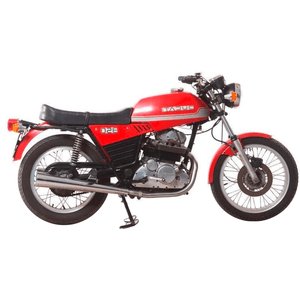Ducati 350 GTL (1975-1977) Review: A Slice of Italian Motorcycling Heritage
Introduction
The mid-1970s were a golden era for motorcycling, and Ducati’s 350 GTL stands as a fascinating artifact of this period—a machine that blends Italian passion with practical touring ambitions. Designed during an era when manufacturers experimented wildly with form and function, the 350 GTL occupies a unique niche between sporty agility and relaxed cruising. While not as famous as its larger Pantah or bevel-drive siblings, this 350cc twin offers a distinct ownership experience that continues to charm vintage motorcycle enthusiasts today. After spending time with a meticulously maintained example, here’s why this underdog deserves a closer look.
Design & Styling: La Dolce Vita on Two Wheels
The Ducati 350 GTL wears its 1970s heritage proudly. The angular fuel tank, slim bench seat, and chrome-accented fenders reflect the era’s love affair with geometric designs. Unlike the flamboyant paint schemes of Japanese competitors, Ducati kept things classy with simple color options like metallic green and burgundy, often paired with subtle pinstriping.
The trellis frame—a Ducati hallmark—is partially visible beneath the bodywork, hinting at the bike’s engineering priorities. At 188 kg (414 lbs), the GTL feels substantial for a 350cc machine, but the weight distribution is surprisingly neutral. The riding position strikes a balance between sporty and comfortable: low, wide handlebars encourage slight forward lean, while the seat’s gentle rise supports longer rides.
Notable Details:
- Twin analog gauges (speedometer and tachometer) with chrome housings
- Spoked wheels with ribbed alloy rims for reduced unsprung weight
- A single, circular headlight dominating the minimalist front profile
Performance: A Gentleman’s Express
Engine Character
The 350 GTL’s air-cooled, 340cc (21 cubic inches) twin-cylinder engine produces 27 PS (20 kW), which translates to a modest but usable powerband. Unlike the frenetic two-strokes of its time, this Ducati rewards patience. The engine thrives between 4,000–7,000 RPM, delivering smooth acceleration rather than neck-snapping thrust. Top speed hovers around 140 km/h (87 mph), but the real joy lies in maintaining 90–110 km/h (56–68 mph) on open roads, where the exhaust note evolves into a melodic hum.
The desmodromic valve system—a Ducati signature—requires precise maintenance but eliminates valve float at high revs. Paired with a 5-speed transmission, the gearbox feels agricultural by modern standards, yet shifts with satisfying mechanical clunks.
Handling & Ride Quality
Despite its weight, the 350 GTL handles twisty roads with grace. The Marzocchi front forks and dual rear shock absorbers offer a plush ride, absorbing bumps without wallowing. The narrow tires (3.25-18 front, 3.50-18 rear) provide ample grip for spirited cornering, though modern riders might find the steering slightly heavy at low speeds.
Braking is handled by a single 260mm front disc (a rarity in the 1970s for small-displacement bikes) and a rear drum. While adequate for the bike’s performance, the disc benefits from fresh DOT 4 fluid and quality brake pads—a worthwhile upgrade for spirited riders.
Competition: How Does the 350 GTL Stack Up?
In the 350cc class, the Ducati faced fierce rivals:
-
Honda CB350
Honda’s parallel twin was smoother and more reliable, with 36 PS. However, it lacked the Ducati’s charisma and handling precision. -
Yamaha RD350
The RD’s two-stroke engine delivered explosive power (39 PS) but demanded constant maintenance. The Ducati appealed to riders seeking refinement over raw speed. -
Moto Guzzi V35
Guzzi’s transverse V-twin offered shaft drive and lower vibrations but arrived later (1977). The 350 GTL predates it and caters to a purist crowd.
Verdict: The Ducati carved a niche for riders valuing mechanical uniqueness and touring potential. It’s less practical than Japanese bikes but oozes personality—a trade-off that still resonates today.
Maintenance: Keeping the 350 GTL Thriving
Owning a vintage Ducati requires dedication, but the 350 GTL is relatively straightforward compared to its high-strung siblings. Key considerations:
Critical Components
- Spark Plugs: NGK B6HS (standard) or iridium BR6HIX for longer service intervals. Check gaps at 0.5mm (0.02 inches).
- Valve Adjustments: Desmodromic valves need clearance checks every 5,000 km (3,100 miles).
- Belt Drive: Unlike later Ducatis, the 350 GTL uses a chain final drive—simpler to maintain but requires regular lubrication.
- Brake Fluid: Flush DOT 4 fluid annually to prevent moisture buildup.
Upgrades & Troubleshooting
- Electronics: Many owners retrofit electronic ignitions to replace the points system.
- Carburetion: The stock 24mm Dell’Orto carbs can be finicky in humid climates; ethanol-resistant seals are a wise investment.
- Fuel System: The 19-liter (5-gallon) tank offers excellent range (~300 km / 186 miles), but inspect for rust if the bike sat unused.
MOTOPARTS.store Recommendations:
- High-quality NGK spark plugs for consistent ignition
- DOT 4 brake fluid kits with anti-corrosion additives
- Retro-style tires balancing period aesthetics and modern grip
Conclusion: Timeless Charm Meets Riding Soul
The Ducati 350 GTL isn’t the fastest or most practical classic bike, but it embodies an era when motorcycles were mechanical artworks first and transportation second. Its quirks—the desmo valve symphony, the tactile feedback through narrow bars, the way it leans into corners like a seasoned dancer—create a connection missing from sanitized modern machines. For riders seeking a vintage experience that’s equal parts challenging and rewarding, the 350 GTL remains a compelling choice. And when it’s time to pamper your Italian classic, MOTOPARTS.store has the expertise and parts to keep every ride as thrilling as the first.



















